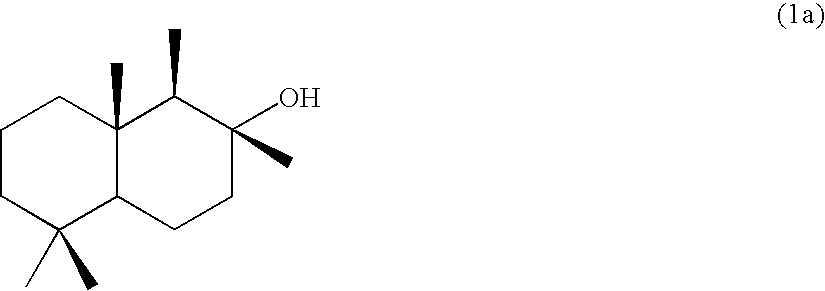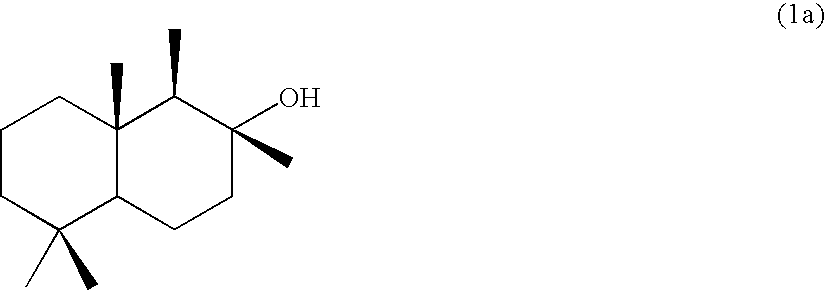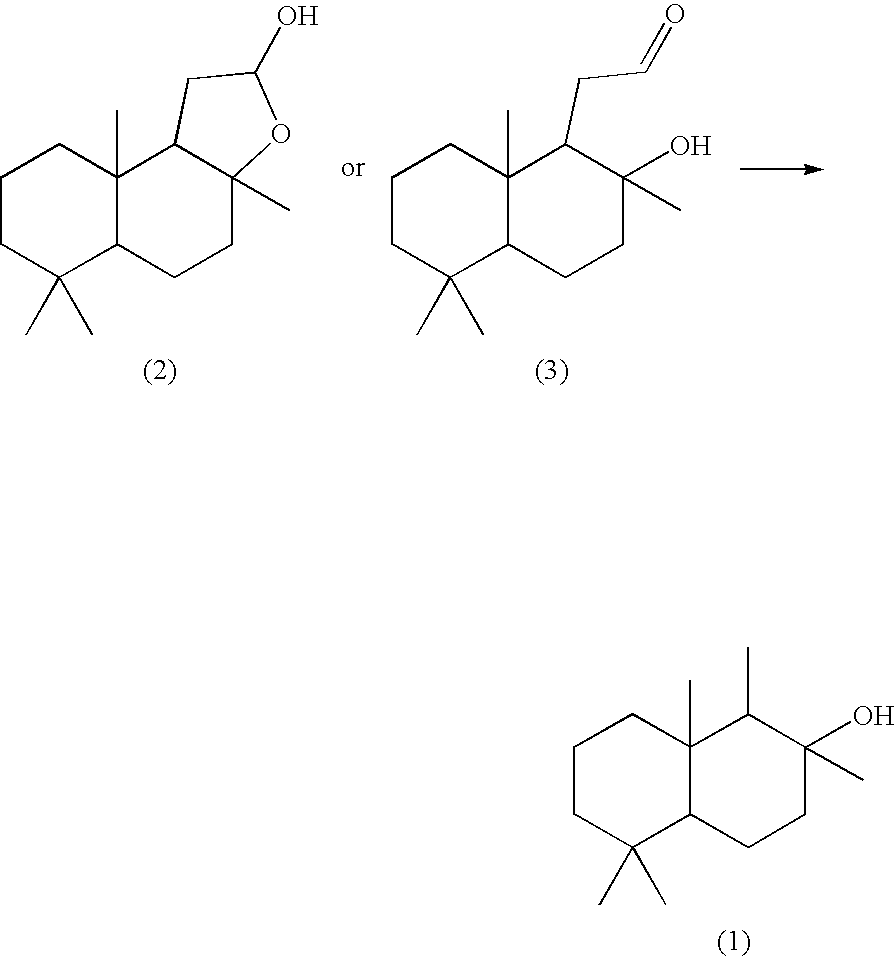Fragrance composition
- Summary
- Abstract
- Description
- Claims
- Application Information
AI Technical Summary
Benefits of technology
Problems solved by technology
Method used
Image
Examples
production example 1
[0061][Production of 8-drimanol (1a)]
[0062]In a 200-mL four-necked flask equipped with a stirrer and a thermometer, 5 g of (+)-sclareolide and 60 mL of anhydrous dichloromethane were placed in a nitrogen atmosphere and cooled while stirring down to −78° C. To the solution thus prepared, 22 mL of a n-hexane solution of diisobutylaluminum hydride was slowly added dropwise by using a syringe and stirred while cooling for 25 minutes. Thereafter, 12.5 mL of a saturated aqueous solution of ammonium chloride was added slowly and the solution was heated while stirring up to room temperature. The solution was diluted with diethyl ether, then stirred for 1.5 hours, then anhydrous magnesium sulfate was added and stirred for a while, and then filtered with celite. The filtrate was concentrated by removal under reduced pressure to yield 4.75 g (yield: 95%) of a white crystal (a mixture of hemiacetal (2a) and aldehyde (3a)).
[0063]Next, 2 g of the obtained solid substance was dissolved in 320 mL o...
production example 2
[0071][Production of 8-drimanol (1a) with a catalyst amount of 0.034 equivalent]
[0072]In a 300 mL four-necked flask equipped with a thermometer, a refluxing tube and a stirrer bar, 1.92 g (2.08 mmol) of chlorotris(triphenylphosphine)rhodium(I), 1.89 g (4.58 mmol) of 1,3-bis(diphenylphosphino)propane and 139 mL of dehydrated xylene were placed, and the air in the flask was replaced with nitrogen. Then, the reaction mixture was heated to an oil-bath temperature of 80° C., and heated as it was while stirring for 15 minutes. Then, to the flask, 15.36 g (60.9 mmol) of a mixture of hemiacetal (2a) and aldehyde (3a) obtained in the same manner as in Production Example 1 was added, and the reaction mixture was heated to an oil-bath temperature of 155° C., and heated under refluxing and while stirring for 9 hours. After cooling the reaction mixture, the solid substance was removed by filtration, and the filtrate was concentrated and subjected three times to silica gel column purification (he...
production example 3
[0073][Production of 8-drimanol (1a) with a Catalyst Amount of 0.0025 Equivalent]
[0074]In a 100 mL four-necked flask equipped with a thermometer, a refluxing tube and a stirrer bar, 0.139 g (0.15 mmol) of chlorotris(triphenylphosphine)rhodium(I), 0.068 g (0.165 mmol) of 1,3-bis(diphenylphosphino)propane and 10 mL of dehydrated xylene were placed, and the air in the flask was replaced with nitrogen. Then, the reaction mixture was heated to an oil-bath temperature of 80° C., and heated as it was while stirring for 15 minutes. Then, to the flask, 1.27 g (5 mmol) of a mixture of hemiacetal (2a) and aldehyde (3a) obtained in the same manner as in Production Example 1 was added, and the reaction mixture was heated to an oil-bath temperature of 155° C., and heated under refluxing and while stirring in a flow of nitrogen. After an elapsed time of 8 hours, 0.068 g (0.165 mmol) of 1,3-bis(diphenylphosphino)propane was further added to improve the reaction rate, and after a total elapsed time ...
PUM
| Property | Measurement | Unit |
|---|---|---|
| Percent by mass | aaaaa | aaaaa |
| Percent by mass | aaaaa | aaaaa |
| Percent by mass | aaaaa | aaaaa |
Abstract
Description
Claims
Application Information
 Login to View More
Login to View More - R&D
- Intellectual Property
- Life Sciences
- Materials
- Tech Scout
- Unparalleled Data Quality
- Higher Quality Content
- 60% Fewer Hallucinations
Browse by: Latest US Patents, China's latest patents, Technical Efficacy Thesaurus, Application Domain, Technology Topic, Popular Technical Reports.
© 2025 PatSnap. All rights reserved.Legal|Privacy policy|Modern Slavery Act Transparency Statement|Sitemap|About US| Contact US: help@patsnap.com



